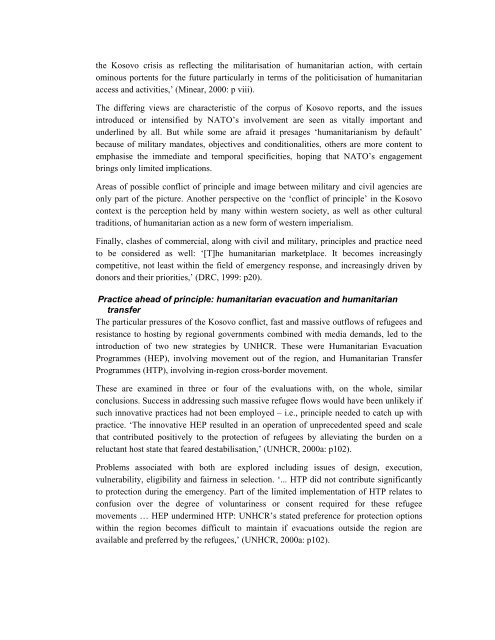Download PDF - ReliefWeb
Download PDF - ReliefWeb
Download PDF - ReliefWeb
You also want an ePaper? Increase the reach of your titles
YUMPU automatically turns print PDFs into web optimized ePapers that Google loves.
the Kosovo crisis as reflecting the militarisation of humanitarian action, with certain<br />
ominous portents for the future particularly in terms of the politicisation of humanitarian<br />
access and activities,’ (Minear, 2000: p viii).<br />
The differing views are characteristic of the corpus of Kosovo reports, and the issues<br />
introduced or intensified by NATO’s involvement are seen as vitally important and<br />
underlined by all. But while some are afraid it presages ‘humanitarianism by default’<br />
because of military mandates, objectives and conditionalities, others are more content to<br />
emphasise the immediate and temporal specificities, hoping that NATO’s engagement<br />
brings only limited implications.<br />
Areas of possible conflict of principle and image between military and civil agencies are<br />
only part of the picture. Another perspective on the ‘conflict of principle’ in the Kosovo<br />
context is the perception held by many within western society, as well as other cultural<br />
traditions, of humanitarian action as a new form of western imperialism.<br />
Finally, clashes of commercial, along with civil and military, principles and practice need<br />
to be considered as well: ‘[T]he humanitarian marketplace. It becomes increasingly<br />
competitive, not least within the field of emergency response, and increasingly driven by<br />
donors and their priorities,’ (DRC, 1999: p20).<br />
Practice ahead of principle: humanitarian evacuation and humanitarian<br />
transfer<br />
The particular pressures of the Kosovo conflict, fast and massive outflows of refugees and<br />
resistance to hosting by regional governments combined with media demands, led to the<br />
introduction of two new strategies by UNHCR. These were Humanitarian Evacuation<br />
Programmes (HEP), involving movement out of the region, and Humanitarian Transfer<br />
Programmes (HTP), involving in-region cross-border movement.<br />
These are examined in three or four of the evaluations with, on the whole, similar<br />
conclusions. Success in addressing such massive refugee flows would have been unlikely if<br />
such innovative practices had not been employed – i.e., principle needed to catch up with<br />
practice. ‘The innovative HEP resulted in an operation of unprecedented speed and scale<br />
that contributed positively to the protection of refugees by alleviating the burden on a<br />
reluctant host state that feared destabilisation,’ (UNHCR, 2000a: p102).<br />
Problems associated with both are explored including issues of design, execution,<br />
vulnerability, eligibility and fairness in selection. ‘... HTP did not contribute significantly<br />
to protection during the emergency. Part of the limited implementation of HTP relates to<br />
confusion over the degree of voluntariness or consent required for these refugee<br />
movements … HEP undermined HTP: UNHCR’s stated preference for protection options<br />
within the region becomes difficult to maintain if evacuations outside the region are<br />
available and preferred by the refugees,’ (UNHCR, 2000a: p102).
















![CynefinFramework final [Read-Only]](https://img.yumpu.com/19017304/1/190x135/cynefinframework-final-read-only.jpg?quality=85)